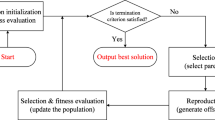Abstract
Traditional evolutionary computing techniques use an explicit fitness function – mathematical or simulated – to derive a solution to a problem from a population of individuals, over a number of generations. In this paper an approach which allows such techniques to be used on problems in which evaluations are costly, which cannot be expressed formally, or which are difficult to simulate, is examined. A neural network is trained using example individuals with the explicit fitness and the resulting model of the fitness function is then used by the evolutionary algorithm to find a solution. It is shown that the approach is effective over a small range of function types in comparison to the traditional approach when limited training data is available. An iterative step is then added whereby after a number of generations the current best individual in a population is evaluated directly on the explicit fitness function. The individual and its “real” fitness are then added to the training data and the neural network is re-trained to improve its approximation of the fitness function. It is shown that in this way the performance of the model-based architecture is greatly improved on more rugged/complex landscapes without a large increase in the amount of training data required.
Similar content being viewed by others
Explore related subjects
Discover the latest articles and news from researchers in related subjects, suggested using machine learning.Author information
Authors and Affiliations
Rights and permissions
About this article
Cite this article
Bull, L. On Model-Based Evolutionary Computation. Soft Computing 3, 76–82 (1999). https://doi.org/10.1007/s005000050055
Issue Date:
DOI: https://doi.org/10.1007/s005000050055




